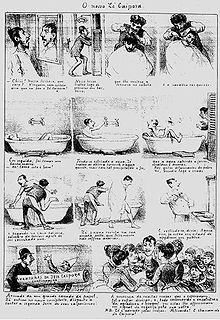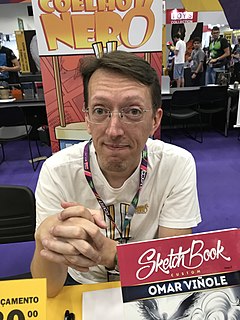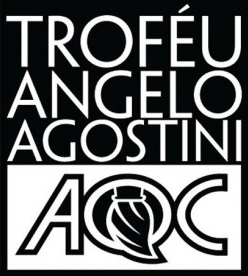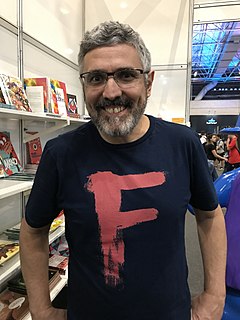
Brazilian comics started in the 19th century, adopting a satirical style known as cartoon, charges or caricature that would later be cemented in the popular comic strips. The publication of magazines dedicated exclusively to comics, in Brazil, started at the beginning of the 20th century. Brazilian artists have worked with both styles. In the case of American comics some have achieved international fame, like Roger Cruz with X-Men and Mike Deodato with Thor, Wonder Woman and others.

André Diniz is a Brazilian comics artist. He began working with comics in 1994 with the fanzine Grandes Enigmas da Humanidade, which had a circulation of 5,000 copies.

Omar Viñole is a Portuguese-born Brazilian comics artist, colorist and inker. He and Laudo Ferreira Jr. founded the Banda Desenhada studio in 1996, in which Omar made colors and inks for many comics projects, as Yeshuah, Histórias do Clube da Esquina and Depois da Meia-Noite. He was awarded as "Best inker" in 2003 and 2017. In 2009, he created the webcomic Coelho Nero, a grumpy and critical rabbit, which has two printed collections.

Prêmio Angelo Agostini, sometimes also called Troféu Angelo Agostini, is the most traditional comics award in Brazil. It was created in 1985 by the Associação dos Quadrinhistas e Caricaturistas do Estado de São Paulo (AQC-ESP), which still organizes the event today.
Franco de Rosa is a Brazilian journalist, editor and comics artist. He started his career in 1974, with the comic strips Chucrutz and Capitão Caatinga, published in some Brazilian newspapers, such as Notícias Populares. From 1980, he started to make illustrations for newspapers and magazines. In 1984 he founded, alongside Paulo Paiva, the publishing house Maciota, which lasted until the 1990s. In 1997, he founded, alongside Dorival Vitor Lopes and Hélcio de Carvalho, the publishing house Mythos Editora. Rosa won the Troféu Jayme Cortez in 1990 and 1991, the Prêmio Angelo Agostini as best editor in 2003 and 2004 and as "Master of the National Comics" category in 2010.

Sidney Gusman is a Brazilian journalist and editor. Gusman graduated in journalism at the Methodist University of São Paulo and started writing professionally about comics in 1990, with articles published in newspapers such as Folha de S.Paulo, O Estado de S. Paulo, among others, as well as magazines such as Imprensa, Superinteressante, Duas Rodas etc. Between 2003 and 2006 he was editor of the Brazilian version of Wizard magazine. In 2006, he became responsible for the Editorial Planning area of Mauricio de Sousa Produções, where, among several other projects, he was the creator of the Graphic MSP series, which since 2012 has published several graphic novels with reinterpretations of the classic characters created by Mauricio de Sousa by several Brazilian artists. He is also editor-in-chief of Universo HQ, the most important news portal about comics in Brazil. Gusman won the Troféu HQ Mix as best specialized journalist seven times. He also won the Troféu Jayme Cortez twice, in 2004 and 2014.

Master of National Comics is one of the categories of Prêmio Angelo Agostini, the most traditional Brazilian award dedicated to comics that has been held since 1985 by Associação dos Quadrinhistas e Caricaturistas do Estado de São Paulo (AQC-ESP).
Rodolfo Zalla was an Argentine comics artist. He started drawing comics while still in Argentina in 1953, but his career gained prominence after moving to Brazil with fellow comic artist José Delbo in 1963. He started producing comic strips of characters such as Targo, O Vingador and O Escorpião. He has worked for several comic book publishers and has produced stories in various genres, such as war and terror. He also produced Disney Comics about Zorro for editora Abril. In 1985, he was awarded the Prêmio Angelo Agostini for Master of National Comics, an award that aims to honor artists who have dedicated themselves to Brazilian comics for at least 25 years. He remained active drawing comics until his death in 2016, at 84 years old.
Eugenio Colonnese was an Italian-born Brazilian comic artist. Son of a Brazilian mother and Italian father, Colonnese moved to Argentina as a child, where he began his career in 1949, working for several Argentine magazines. He moved to Brazil in 1964. Three years later, he created the Estúdio D-Arte with Rodolfo Zalla, with whom he produced several comic books for several Brazilian publishers. In 1967, Colonnese created his main characters: Mirza, a Mulher-Vampira and O Morto do Pântano, which, although they have similarities, respectively, to Vampirella and Swamp Thing, were created some years before these characters.Colonnese worked mainly with horror comics, but he also worked with other genres and did illustration for educational and advertising comics. In 1985, he was awarded the Prêmio Angelo Agostini for Master of National Comics, an award that aims to honor artists who have dedicated themselves to Brazilian comics for at least 25 years.
Gedeone Malagola was a Brazilian comics artist and editor. He started his career in the 1940s, drawing for the newspaper A Marmita. He worked for several comic book publishers until he founded his own, Editora Júpiter. His main works were in the 1960s at GEP, where he created the superheroes Raio Negro, Hydroman and Homem Lua. In the late 1960s, Malagola wrote unofficial stories of the X-Men for GEP. In 1986, he was awarded the Prêmio Angelo Agostini for Master of National Comics, an award that aims to honor artists who have dedicated themselves to Brazilian comics for at least 25 years.
Flavio Colin was a Brazilian comic artist and illustrator, considered one of the most important comic artists in Brazil. He began his career in the 1950s with an adaptation for the comic book radio series As Aventuras do Anjo, influenced by Milton Caniff, but began to gain prominence with the development of his own stylized artist style. In 1987, he was awarded with the Prêmio Angelo Agostini for Master of National Comics, an award that aims to honor artists who have dedicated themselves to Brazilian comics for at least 25 years. He also won the Troféu HQ Mix in 1994 and 1995. Flávio Colin died in Rio de Janeiro on 2002.
Sérgio Lima (1925–1988) was a Brazilian illustrator and comics artist. In the 1960s, he worked at the publishing house Prelúdio, where he illustrated cordel leaflets and comic books such as Juvêncio, o justiceiro do sertão, as well as adaptations of cordel literature. He also illustrated the comic book biography of Silvio Santos, written by R. F. Lucchetti, as well as horror comics. In the 1970s, he started to create Disney comics at editora Abril and worke in Os Trapalhões comic book. In 1987, he was awarded with the Prêmio Angelo Agostini for Master of National Comics, an award that aims to honor artists who have dedicated themselves to Brazilian comics for at least 25 years.
Cláudio Seto was a Brazilian journalist, visual artist, comic artist, poet, photographer, cultural animator and bonsai artist. Of Japanese descent, at age nine he went to study at a Zen monastery in Japan, where he took the opportunity to visit Osamu Tezuka's studio on weekends. When he returned to Brazil in the 1960s, he was hired by Edrel publishing house, where he published stories about samurai and ninja, who were still little known by Brazilians. Seto is considered the forerunner of the use of the manga style in Brazilian comics and his best-known character was O Samurai. In the 1970s, he moved to Curitiba to work at the Grafipar publishing house, which had hired some of the best Brazilian comic artists of the time. In 1988, he was awarded with the Prêmio Angelo Agostini for Master of National Comics, an award that aims to honor artists who have dedicated themselves to Brazilian comics for at least 25 years.
Álvaro de Moya was a Brazilian journalist, professor, researcher, comics artist, illustrator, writer and TV producer. He was one of the pioneers in academic research on comics in Brazil and one of those responsible for the First International Exhibition of Comics, held in São Paulo in 1951. Moya worked on the Disney comics published by Editora Abril, published novel adaptations at the EBAL publishing house, and made cartoons, illustrations and articles about comics for several newspapers. His first book, Shazam!, published in 1970, is considered one of the most important for Brazilian research on comics. In 1989, he was awarded with the Prêmio Angelo Agostini for Master of National Comics, an award that aims to honor artists who have dedicated themselves to Brazilian comics for at least 25 years.
Waldyr Igayara de Souza was a Brazilian comic book artist and editor. He started his career working for the Outubro and Taika publishing houses, as well as the studio Alcântara Machado Propaganda, along with Lyrio Aragão, Julio Shimamoto and Luiz Saidenberg. In 1961, he started working at editora Abril, being one of the first Brazilian artists to work with Disney comics at the publishing house. He created the character Dugan Duck, nephew of Fethry Duck. The character was quite successful in Brazil and Italy, being the only duck with a yellow color. Igayara also worked as editorial director of Abril's children's division for 20 years, creating important children's magazines such as Recreio e Alegria. In 1993, he was awarded with the Prêmio Angelo Agostini for Master of National Comics, an award that aims to honor artists who have dedicated themselves to Brazilian comics for at least 25 years.
Edson Rontani was a Brazilian illustrator and fanzine editor, known for having created the first Brazilian fanzine about comics.
Ivan Wasth Rodrigues was a Brazilian painter and comics artist. He learned painting at the ateliers of José Wasth Rodrigues, Cid Affonso Rodrigues and Vittorio Gobbis, and also at the Escola de Belas-Artes de São Paulo. He started his professional career as a book illustrator for the Melhoramentos publishing house and doing advertising design. In the field of comics, he designed a two-part book for EBAL publishing house on the history of Brazil and the adaptation of the classic Casa-Grande & Senzala, by Gilberto Freire. For Freire's book, which talks about the period of slavery in Brazil, Wasth Rodrigues researched for five months the paintings of Jean-Baptiste Debret. In 2001, he was awarded with the Prêmio Angelo Agostini for Master of National Comics, an award that aims to honor artists who have dedicated themselves to Brazilian comics for at least 25 years.
Bigorna was a Brazilian website about comics with an almost exclusive focus on Brazilian comics.




